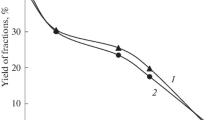Abstract
Experimental data on the briquetting of waste coals different in moisture contents and physical states with a binding agent for power-generating purposes are presented. A method for decreasing the moisture content of the briquetted waste coal is described. The proximate analysis of fuel briquettes from experimental batches is reported. A mechanism is proposed for the strengthening of fuel compositions.
Similar content being viewed by others
References
Krapchin, I.P. and Mitrofanov, V.O., Ugol’, 2001, no. 7, p. 19.
Buravchuk, N.I. and Gur’yanova, O.V., RF Patent 2396306, Byull. Izobret., 2010, no. 22, p. 12.
Buravchuk, N.I. and Gur’yanova, O.V., Khim. Tverd. Topl. (Moscow), 2015, no. 5, p. 25.
Elishevich, A.T., Briketirovanie uglya so svyazuyushchimi (Coal Briquetting with Binding Agents), Moscow Nedra, 1972.
Rehbinder, P.A., Poverkhnostnye yavleniya v dispersnykh sistemakh. Fiziko-khimicheskaya mekhanika. Izbrannye trudy (Surface Phenomena in Disperse Systems; Physicochemical Mechanics: Selected Works), Moscow Nauka, 1979.
Author information
Authors and Affiliations
Corresponding author
Additional information
Original Russian Text © N.I. Buravchuk, O.V. Gur’yanova, 2016, published in Khimiya Tverdogo Topliva, 2016, No. 6, pp. 19–24.
About this article
Cite this article
Buravchuk, N.I., Gur’yanova, O.V. Briquetting of coal products with a binding agent. Solid Fuel Chem. 50, 352–356 (2016). https://doi.org/10.3103/S0361521916060021
Received:
Published:
Issue Date:
DOI: https://doi.org/10.3103/S0361521916060021



